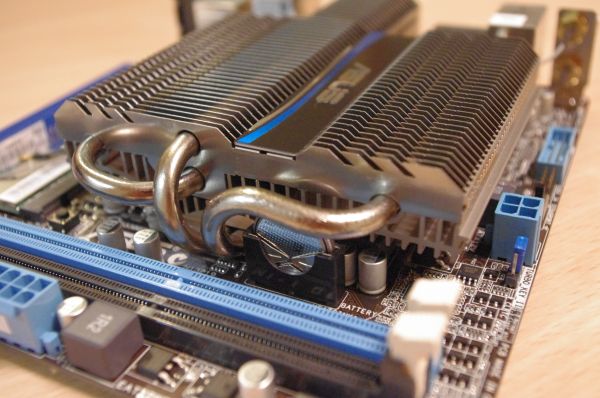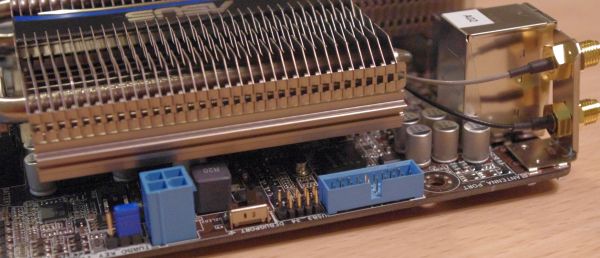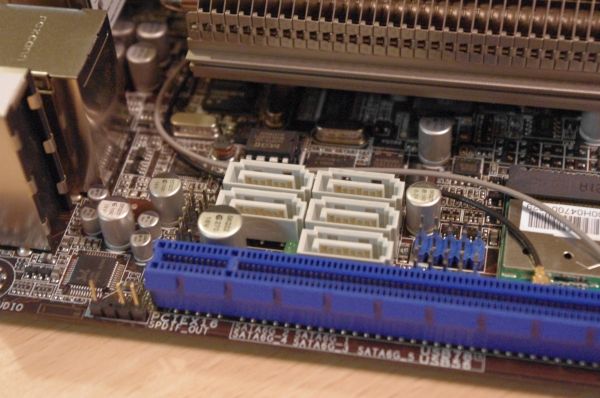Fusion E-350 Review: ASUS E35M1-I Deluxe, ECS HDC-I and Zotac FUSION350-A-E
by Ian Cutress on July 14, 2011 11:00 AM ESTEver since I first tinkered around with the ASUS board, I had a love/hate relationship with it. It's a prime example of what a lot of people may want in a board - it's passive, the wifi is already built in (you just fix the antenna), and it runs straight out of the box. But the more I prodded around the vibrant exterior, I tried to find what I would get for my $175, especially compared to the other boards I have here for review.
Despite the E-350 processor on board, the passive heatsink gets incredibly hot to touch, even at idle in a fanless environment. The CPU itself is rated at 18W, and without a discrete GPU, the board is pulling around 60W in our stringent tests. This is disconcerting, considering that the ECS board (even though it isn't passive) pulls off a 33% overclock. Also, due to the size passive heatsink, the IO panel is hit - the onboard audio has only two outputs and we're limited to DVI and HDMI video. This doesn't happen on the Zotac board, which is also passive.
Visual Inspection
I've mentioned it before and I'll mention it again - heatsink. This motherboard has a massive one, with ASUS on it, just in case you forgot. The heatsink is still shorter than any full height DDR3 memory you put in the DIMM slots, and there are two fan headers found in the top left, just beside the heatsink in that corner.
There is a USB 3.0 header along the top of the board, along with a debug header, a Turbo switch, a 4-pin 12 V CPU connector and the Clear CMOS header. Unfortunately, the writing next to these is all mixed up - the writing above the turbo switch says 'DEBUG PORT' and above the Clear CMOS is 'TURBO_KEY+II'. Nowhere on the board does it say the Clear CMOS is the Clear CMOS - during bad overclocking I had to refer to the manual to find this information.
Thankfully, the front panel connectors are still on the right hand side of the DDR3 DIMM slots (unlike the ECS), and the wifi card is preinstalled in a very tight space the other side of the DIMMs. The five SATA 6 Gbps ports are also here, with USB 2.0 headers, and the MEM OK button which is ASUS' memory adaptation feature if there is incompatibility with any memory module changes. The HD Audio header is on the far left of these headers and ports, which could cause an issue depending on where the cable is coming from and what's installed on the board. There is also a full length PCIe slot - it will accept any 16x peripheral, but run it at 4x speeds, including discrete GPUs.
The I/O panel is a mixture of positive and negative. Because of the large heatsink impinging into the panel, some of the functionality is lost. Alongside the two antenna ports, we have a single PS/2 port, four USB 2.0 ports, two USB 3.0 ports, HDMI (1.3b) and DVI video outputs, optical S/PDIF Out, a Bluetooth receiver, an eSATA 6 Gbps port, an Ethernet port and three audio jacks. The big surprise here is that the HDMI is only 1.3b and not 1.4a...




















67 Comments
View All Comments
triclops41 - Thursday, July 14, 2011 - link
I think Starcraft 2 benchmarks should be included. It is a popular game that can run well on mid and lower end systems.I know it can almost run at lowest settings with the E-350 at stock. But I would really like to know how well SC2 runs when the E-350 is overclocked to 2.1Ghz, considering it was CPU limited before.
Phynaz - Thursday, July 14, 2011 - link
Not single test doing video decode and display = fail.Finally - Thursday, July 14, 2011 - link
...you are taking a Bobcat APU (that's made for netbooks, HTPC and other low power usage devices) and test it on ground of performance by pairing it with a 1000W power supply. (Ian was clever enough not to mention his batshit crazy choice by simply stating "Silverstone 80+ Silver" on the hardware page - a quick check on geizhals.at reveals that there are only 4 power supplies that fall into this category, starting @ 700W and going up to 1000W -> http://geizhals.at/deutschland/?cat=gehps&xf=1...To further add insult to injury he then pairs this netbook APU with a Nvidia 580GTX only to finish this ridiuculousness for good with overclocking the shit out of the CPU...
Come on? What will be tested next? How far the SoC can be thrown when it's raining?
The thing I like best on AnandTech is how your pro-Intel-agitprop is actually brought to words: "Hudson-M1 - why would I want it?" - Imagine this same question being asked when Intel's Atom platform is the topic of the day... mark it well, because that will be the moment hell freezes over...
AnandThenMan - Thursday, July 14, 2011 - link
You're wasting your time. AMD will never get a fair shake on this site, not going to happen. Every notice how there is never a situation where a "mistake" or other choice accidentally gave AMD an unfair advantage? Why is that? Because these choices are on purpose, and are carefully selected to minimize the AMD product as much as possible, while still trying to maintain the appearance of impartiality.This site is a shill of Intel, and the only reason people don't believe that is because it's a hard thing to accept. But the evidence is overwhelming. At one time, there was an entire section of this website dedicated to only Intel, anyone else remember that?
Broheim - Friday, July 15, 2011 - link
if the reviews bother you that much, then why do you come back? is your life really that empty?medi01 - Sunday, July 17, 2011 - link
Somebody has to compensate for shit in articles at least in comments.Broheim - Sunday, July 17, 2011 - link
if "somebody" is dissatisfied, then "somebody" can go make their own hardware review site and review stuff like "somebody" wants to...in the meantime, "somebody" doesn't have to "compensate for shit".
IanCutress - Thursday, July 14, 2011 - link
As I've mentioned, the PSU issue is purely due to what I have available for testing. The GTX580 test, also as I've mentioned, was to provide a plausible maximum ceiling in those tests, and to explore the CPU power with the PCIe x4 against the iGPU. Regarding overclocking - there are people who will overclock everything and anything, regardless of what it's used for. In my mind, it's a valid test - if the platform has headroom with no negative consequences, that's something to look out for, and which to a certain extent the ECS board provided.I'm neither pro-Intel or pro-AMD. I review what I feel is right for the time and situation, and what circumstances allow. We have a series of 9-series boards to look at in the near future, but so far this year all the releases for me to focus on have been Intel based, especially in the motherboard segment. The comment regarding 'why would I want it' was the exact speculative comment I made when the boards came through my door. It's what I ask every board that passes through my hands - if a reviewer didn't ask this, there would be no point him or her reviewing it.
I'm more than open to suggestions by email if there are other tests you think should be added. If there is time and an apt reason to run them (and everyone will be able to interpret the results), I will take a look - the development of testing is always fluid.
Ian
AnandThenMan - Thursday, July 14, 2011 - link
In the interest of full disclosure and proper review procedures, please correct the chart to indicate the make/model/wattage of the power supply, instead of simply "Silverstone 80 PLUS Silver".andymcca - Friday, July 15, 2011 - link
^^ This.And honestly, it should be noted clearly, in plain sight, that power consumption figures are totally meaningless at <5% PSU load.
It's fine that this is the only PSU you have on hand, but (lacking DC power figures, which obviously require special equipment) a low power PSU, preferably a PicoPSU (with a decent brick) or equivalent, is the only reasonable choice here for power testing. Under-loading a PSU can give very misleading results, which deserve a footnote.